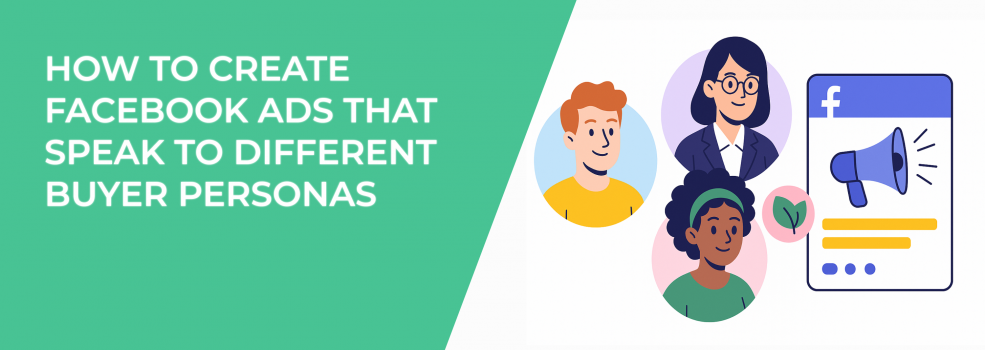Effective Facebook advertising depends on more than just visuals and clever copy. To drive real results, you need to tailor your message to distinct buyer personas — people with different needs, behaviors, and goals.
That means ditching broad messaging and getting specific. Every ad should feel like it was created for a real person with a real reason to click.
Why Buyer Personas Matter in Facebook Ad Campaigns
Facebook and Instagram users scroll for a variety of reasons. Some are actively shopping. Others are just killing time. Each group responds to different types of messaging.
Understanding your audience's goals, pain points, and triggers will help you create different buyer personas and then run ads tailored specifically for them.
Buyer personas help advertisers match ad content to real-world behaviors and motivations. Instead of targeting vague demographics, personas give structure to how you speak to:
-
Value-driven shoppers, looking for the best deal;
-
Impulse buyers, who respond to emotion;
-
Analytical users, who need proof and details;
-
Loyal customers, who want VIP treatment;
-
First-time visitors, who need education before commitment.
By mapping out personas, advertisers avoid guesswork and gain clarity on what kind of content each group responds to — from awareness to conversion.
If you're still unsure how to define clear personas, check out our step-by-step guide to defining a target audience for marketing.
Tips for Building Effective Facebook Buyer Personas
You don’t need dozens of personas to make this work. Focus on 3–5 core types based on data you already have. Start by reviewing purchase history, on-site behavior, and engagement patterns.
For each persona, define the following:
-
Primary goals: What are they trying to achieve?
-
Biggest obstacles: What’s stopping them from taking action?
-
Decision style: Do they need facts, social proof, or urgency?
-
Content preferences: Are they watching videos, reading long captions, or reacting to images?
-
Triggers: What sparks action — discounts, testimonials, or solutions to a pain point?
Use surveys, CRM data, social listening, and analytics to refine these insights. Real buyer data will outperform assumptions every time.
Align Ad Creative With Persona Mindsets
A single Facebook ad creative rarely speaks to all personas equally. To make ads more relevant, customize core elements — visuals, messaging, and tone — for each type of buyer.
Here’s how to approach it:
-
Images and video: Match the tone to the persona. Use aspirational visuals for lifestyle buyers, product-focused images for comparison shoppers, or behind-the-scenes footage for curious browsers.
-
Headline and caption: Reflect each persona’s concerns or goals. For example, emphasize safety and simplicity for cautious buyers, while highlighting innovation or exclusivity for early adopters.
-
CTA (Call-to-Action): Vary based on readiness. Use “See How It Works” for research-driven users, or “Claim Your Offer” for action-takers.
Small adjustments in tone and structure can significantly improve engagement rates. Always test multiple versions.
Not sure which formats perform best? Our Ultimate Guide to Facebook Ad Formats breaks down what works in different campaign types.
Segment Campaign Objectives by Buyer Intent
Not all users are at the same stage of the funnel. When building campaigns, align your Facebook campaign objective with where each persona falls in the buying journey.
Use these guidelines:
-
Top of funnel (awareness): Run video view or reach campaigns for new audiences who need education and brand exposure.
-
Middle of funnel (consideration): Use traffic or engagement objectives for users exploring your content or visiting your site.
-
Bottom of funnel (conversion): Choose conversion or catalog sales for retargeting warm leads with high purchase intent.
Selecting the right objective improves ad delivery and prevents wasted budget on mismatched goals.
Smart Targeting: Think Behavior, Not Just Demographics
Many advertisers still rely too heavily on basic audience settings — age, gender, or location — and miss the more nuanced behavioral signals that Facebook offers.
Instead, consider targeting based on:
-
Interests: Pages users engage with that reflect values or hobbies;
-
Engagement history: Video views, form submissions, or past clicks;
-
Lookalike audiences: Based on segmented custom audiences, like recent purchasers or newsletter subscribers;
-
Website actions: Add-to-cart behavior, product views, or checkout initiations.
These signals reveal real intent — not just surface-level traits. The more precisely you define behavior, the better your ad performance.
For deeper persona-based strategies, this breakdown of persona-driven targeting on Facebook shows how to align audience insights with platform features.
Use Dynamic Creative With Purpose
Dynamic creative tools let you test multiple images, headlines, and copy within a single ad. Facebook automatically finds the best-performing combinations based on user interaction.
To make this feature work for buyer personas:
-
Create assets that reflect each persona’s interests or challenges;
-
Don’t include generic combinations — focus on meaningful variations;
-
Analyze which headline-image pairings drive the most clicks and conversions for each segment.
This isn’t about random testing. Structure your dynamic inputs to reflect specific persona strategies, and use results to fine-tune future creative.
Track Performance by Persona — Not Just Campaign
Granular performance tracking helps you understand which personas are converting and which need reworking. Instead of lumping all data into one report, break it down by persona segment.
Track and analyze:
-
CTR and engagement rate, by ad version;
-
Conversion rates, across different creative themes;
-
Cost per result, for each persona-targeted ad set;
-
Time on site and pages viewed, post-click.
Use UTM parameters, Facebook breakdowns, or custom dashboards to isolate this data. These insights shape both creative direction and future ad spend.
Need help interpreting what performance metrics actually mean? Start with How to Analyze Facebook Ad Performance Beyond CTR and CPC.
Final Thoughts: Relevance Drives Results
Creating Facebook ads for multiple buyer personas is essential in today’s performance-driven environment. With tighter competition and algorithmic changes, relevance becomes your most effective tool.
Each audience segment deserves a message built on their motivations — delivered at the right time, in a format they trust. This is how campaigns build interest, encourage action, and increase returns.

